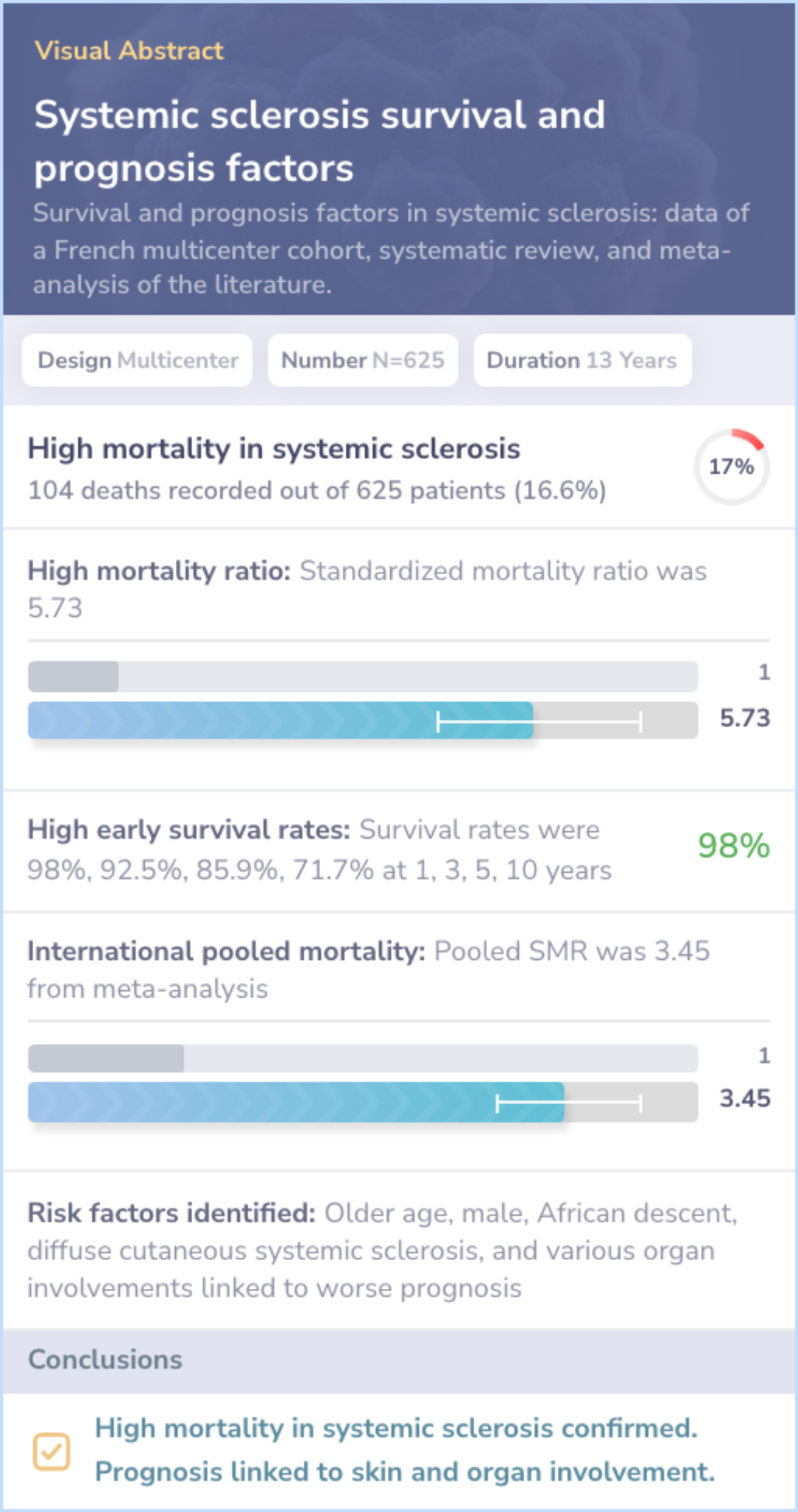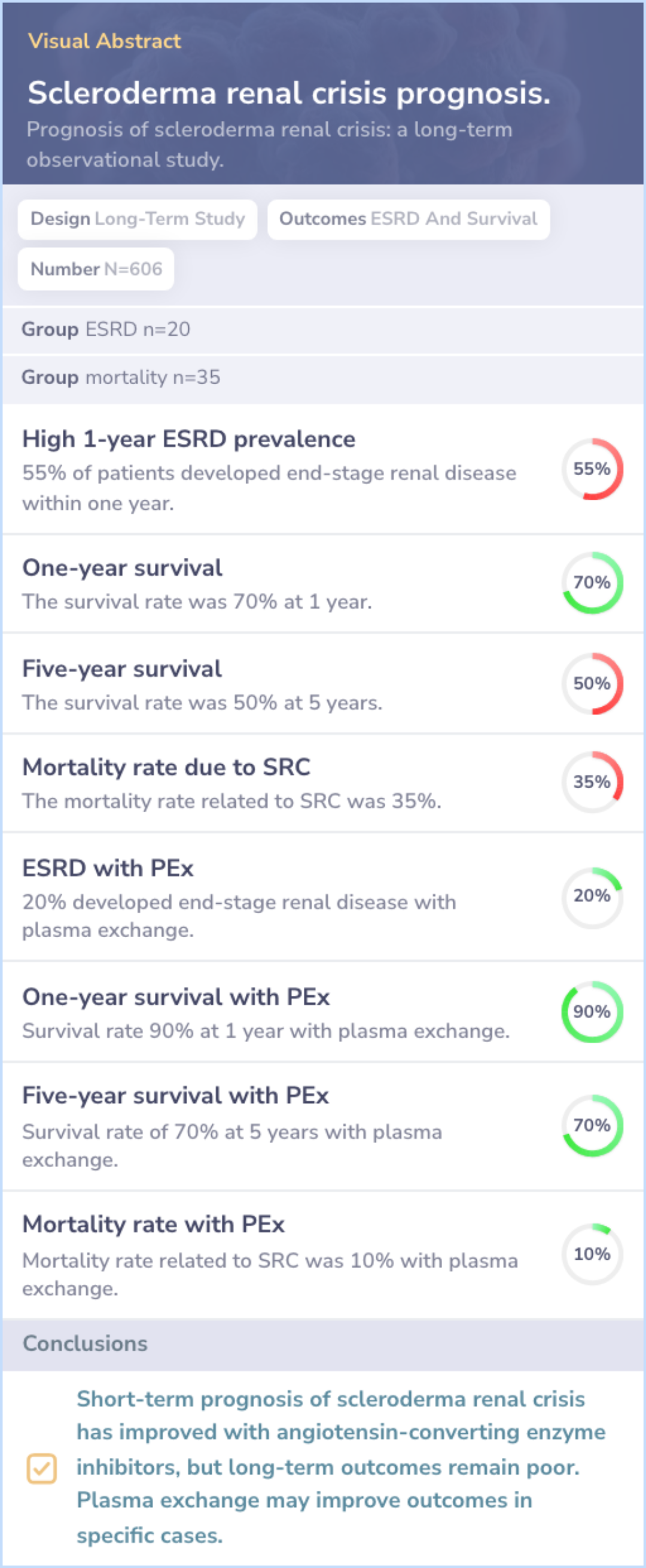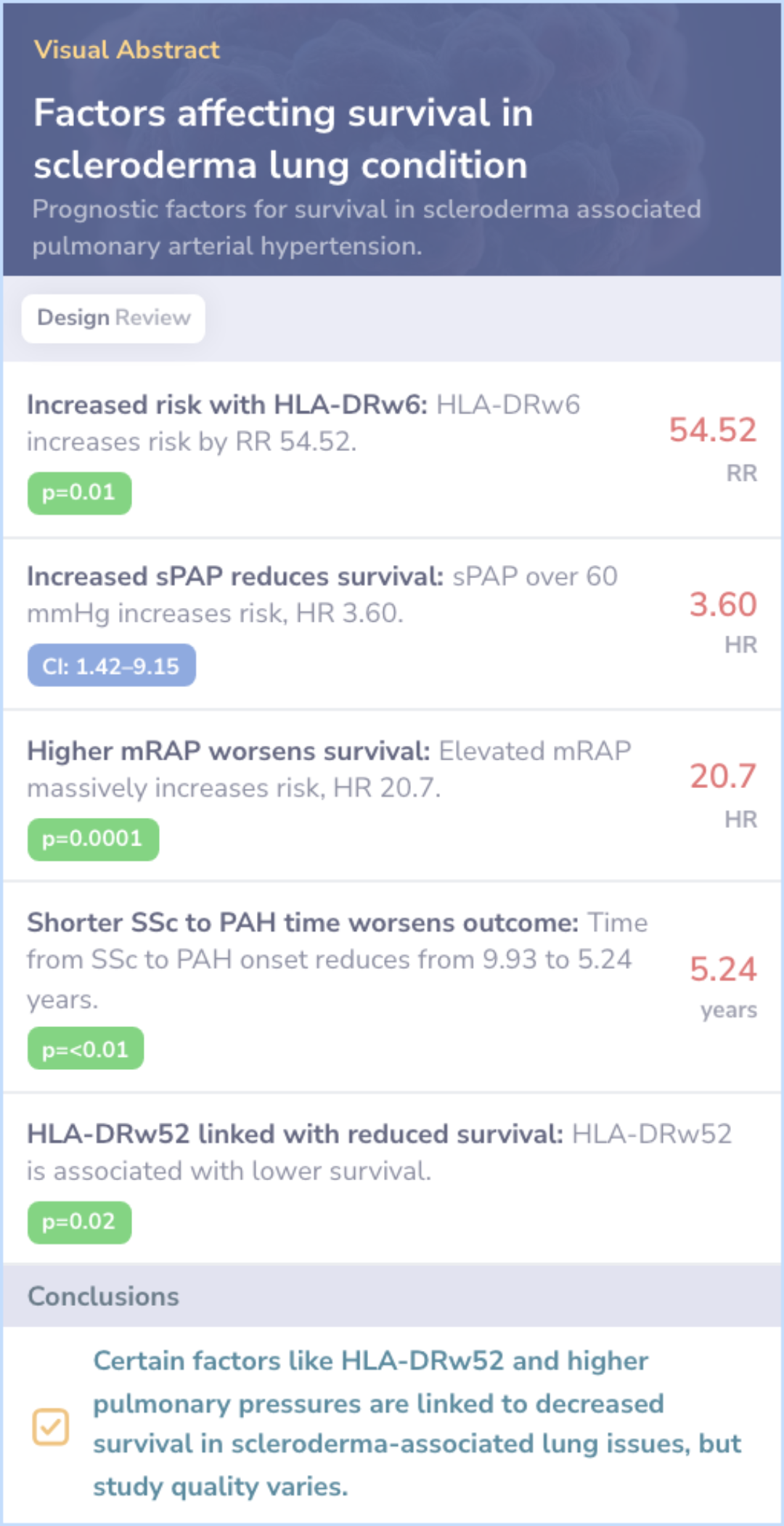Scleroderma
Evidence Based Answers
Scleroderma Prognosis
Scleroderma prognosis varies widely due to symptom and organ involvement differences. Heart, lung, and kidney impact prognosis significantly. While certain treatments show promise, they also pose substantial risks, demanding careful patient evaluation.

Scleroderma outcomes depend on symptoms and organ effects; treatment risk is high.
Scleroderma: A Varied Disease
Scleroderma, also known as systemic sclerosis (SSc), is a complex disease meaning its symptoms and severity can vary greatly among different patients. This can affect multiple organs at different rates for each person, making it challenging to predict outcomes.
This variability is particularly noticeable in clinical trials where evaluating the overall impact of such a diverse disease is complicated.
This variability is particularly noticeable in clinical trials where evaluating the overall impact of such a diverse disease is complicated.
“
Source Quotes:
The disease is rare with heterogeneous clinical manifestations,Clinical diversity and variable natural history make prediction of outcome difficult in placebo-treated patients in randomized trials
SSc is a heterogeneous disease, which is reflected by a broad range of organ involvement, disease progression and severity, and outcomes.
Organ Involvement in Scleroderma
Organ involvement in scleroderma affects prognosis differently. For example, patients with diffuse cutaneous SSc (dcSSc) often experience rapid symptom progression, like skin thickening and lung fibrosis.
Scleroderma renal crisis (SRC) is a severe kidney issue that can arise and is more prevalent in those with dcSSc. Additionally, about 80% of scleroderma patients face lung problems, with pulmonary arterial hypertension (PAH) being particularly serious.
Scleroderma renal crisis (SRC) is a severe kidney issue that can arise and is more prevalent in those with dcSSc. Additionally, about 80% of scleroderma patients face lung problems, with pulmonary arterial hypertension (PAH) being particularly serious.
“
Source Quotes:
Patients with dcSSc... have a rapid progression of skin thickening with early development of lung fibrosis.,Life-threatening renal involvement called SRC develops in up to 10 percent of patients and is far more frequent in ԁсSЅс than lϲЅSϲ.
Some degree of pulmonary involvement is present in more than 80 percent of patients with SSс.
Challenges in Scleroderma Treatment
Treating scleroderma is challenging due to variable outcomes and treatment risks. Autologous hematopoietic stem cell transplantation (HSCT) can be effective in halting disease progression but is associated with high treatment-related mortality.
Certain medications, like long-term glucocorticoids, can lead to severe side effects, such as a renal crisis. Identifying risk factors like diffuse cutaneous involvement and specific antibodies helps understand outcomes, though predicting them is complex.
Certain medications, like long-term glucocorticoids, can lead to severe side effects, such as a renal crisis. Identifying risk factors like diffuse cutaneous involvement and specific antibodies helps understand outcomes, though predicting them is complex.
“
Source Quotes:
Studies of autologous hematopoietic stem cell transplantation (HSCT) have demonstrated efficacy in preventing disease progression in SSc patients.,Long-term, high-dose glucocorticoids are potentially toxic and have been implicated in precipitating renal crisis.
Various risk factors have been associated with increased mortality, including the presence of extensive skin involvement, cardiac and/or pulmonary involvement.
Advancements in Scleroderma Care
Although scleroderma remains serious, patient outcomes have improved, especially in those with diffuse systemic sclerosis (dcSSc). Better medical care and understanding of the disease are contributing to longer survival.
New therapeutic approaches aim to further enhance management of the disease. This includes the development of innovative treatments like immunomodulatory and antifibrotic therapies.
New therapeutic approaches aim to further enhance management of the disease. This includes the development of innovative treatments like immunomodulatory and antifibrotic therapies.
“
Source Quotes:
The overall survival of patients with ЅSс has improved over time, but the proportion of deaths related to ЅSс has increased.,Well-characterized cohorts have reported improvements in survival compared with older cohorts especially in the diffuse subset.
There is an urgent need to improve our repertoire of antifibrotic agents and develop novel therapeutic approaches to SSc.
Key Takeaways
Conclusions
Scleroderma, or systemic sclerosis (SSc), presents a range of challenges due to its complex, multifaceted nature. The disease affects various organs with varying severity, making prognosis particularly unpredictable.
Despite these hurdles, advancements in treatment, especially for diffuse systemic sclerosis, point towards better outcomes. Continued research could bring hope for improved management and survival rates in scleroderma patients.
Despite these hurdles, advancements in treatment, especially for diffuse systemic sclerosis, point towards better outcomes. Continued research could bring hope for improved management and survival rates in scleroderma patients.

Literature Review
Pokeerbux, 2019
Mortality Rates:The study highlights a high mortality rate in systemic sclerosis patients, with a standardized mortality ratio of 5.73 in the French cohort.
Prognostic Factors:
Worse Prognosis Factors: Include age > 60, diffuse type, renal crisis, and pulmonary issues.
Better Prognosis: Presence of anti-centromere antibodies linked to improved survival.
Meta-Analysis Findings:The pooled mortality ratio from multiple studies was 3.45, with similar prognostic factors affecting outcomes.

Literature Review
Cozzi, 2012
Prognosis of Scleroderma Renal Crisis (SRC):
High ESRD and mortality rates: 55% develop end-stage renal disease, 35% mortality in SRC cases.
Survival rates: 70% survive at 1 year, 50% at 5 years post diagnosis.
Impact of additional treatment:
Plasma exchange addition: Decreases ESRD to 20%, raises survival to 90% after 1 year.
Mortality rate improvement: SRC mortality decreases to 10% with plasma exchange.

Literature Review
Johnson, 2008
Factors Linked to Decreased Survival:
Genetic factors: HLA-DRw6 and HLA-DRw52 linked to lower survival
Pulmonary artery pressure: Initial pressure over 60 mmHg reduces survival
Right atrial pressure: High mean pressure linked to lower survival
Onset to PAH duration: Shorter time from disease onset to PAH correlates with reduced survival
Factors Not Linked to Survival:Age, sex, disease subtype, pulmonary fibrosis, and specific antibodies were not clearly associated with survival.
Study Reporting Limitations:Varied reporting quality, lacking details on attrition, confounding, and analysis.
